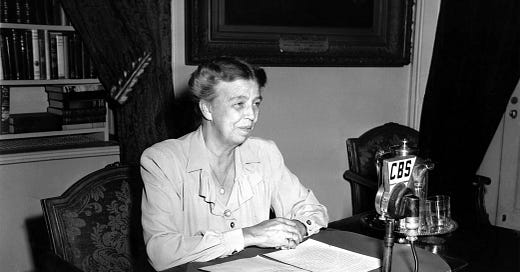Between the agonizing election suspense last week and its final, joyous resolution over the weekend, I did not manage to write a new issue of this newsletter. Instead, here’s an excerpt from Daily Rituals: Women at Work that feels appropriate to this moment of possibility—and to all the hard work that lies ahead.
Eleanor Roosevelt (1884–1962)
Roosevelt may not have been an artist in the traditional sense, but she was certainly a creative force, an instigator of social change through a potent mix of optimism, pragmatism, stubbornness, and steady, ceaseless effort. As America’s longest-serving First Lady, she went on monthly lecture tours, made weekly radio broadcasts, held regular press conferences for female journalists, and, starting in 1936, wrote a syndicated newspaper column, “My Day,” which she filed six days a week for nearly twenty-six years, with virtually no interruptions. After her husband’s death in 1945, Roosevelt became the country’s first delegate to the newly formed United Nations, and the following year she became the first chairperson of the UN Commission on Human Rights, where she was instrumental in drafting the 1948 Universal Declaration of Human Rights. At the same time she was active in countless other causes; she traversed the country for speaking engagements; she was a behind-the-scenes force in Democratic politics; and she wrote several books and stayed on top of a gargantuan correspondence—according to her autobiography, she received about a hundred letters a day, all of which got a reply. (Most of those answers were made by one of Roosevelt’s three assistants, but she personally replied to ten to fifteen letters a day.)
In her book You Learn by Living, Roosevelt considered the problem of how to make the best use of one’s time, a subject on which she clearly had some expertise:




